The Dirt on Onions
Yesterday evening I decided it was time to harvest my patch of storage onions, so I hunkered down and spent about an hour and a half harvesting the onions and another hour and a half carefully laying them out to cure in the greenhouse. The time had long come when I needed to harvest the onions, and with an abundance of rain lately, I was worried about the onions rotting in the field and weeds completely taking over the patch, making it much more difficult to find the onions come harvest time. So with a dry afternoon on hand, I knew it was time to dig in.
This year, I planted two 150-ft beds of onions. Each bed was 4 feet wide and contained 2 or 3 rows of onions. One bed was devoted to “fresh eating” onions, as I like to call them, and the other was set aside for storage onions. The fresh eating onions were onions that I harvested with green tops. They don’t have any of the papery wrappers that you’re used to seeing when you buy a net bag of onions at the store. Instead, they are intended to be eaten fresh, no peeling necessary, and therefore, these onions won’t store long. Generally, they are varieties that are sweeter, containing more sugars, which contributes to their inability to store for a long time, but also makes them delicious raw and helps them to caramelize beautifully. In the fresh eating onion bed, I also included my summer leeks, which take fewer days to reach maturity than fall leek varieties, and are planted closer together so they remain small and slender, never getting bigger than a thumb’s width.

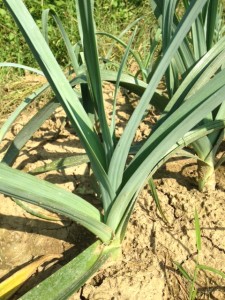
My storage onion bed contains five varieties of onions, all of which store well, according to my seed catalogs. Storage onions tend to be more pungent and less sugary, they make lots of layers of papery wrappers, and they can be cured then stored for months. Some storage onions can even make it through the entire winter if stored properly. The telltale sign that the onions are ready to harvest is when their green tops begin to brown and flop over. The onion is effectively curing itself by sealing off the watery sugars and starches in the bulb by creating a little pinched off crook in its neck where the tops fall over. This way, the green tops won’t transpire water out from the onion bulb.
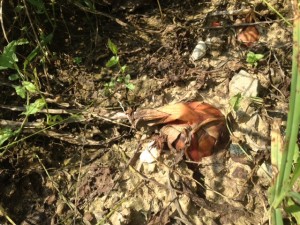

Most of my storage onions had their tops flop over a couple weeks ago, but a few stalwart onions continued to have perky leaves. I picked all of the onions that had flopped and shriveled tops and laid them out in my greenhouse to continue drying for the next week or so. In the greenhouse, they will be protected from rain and receive plenty of heat to ensure their papery wrappers are good and dry for storage. The onions that continued to have perky green tops were all from one variety, Rossa di Milano, a beautiful Italian red onion variety. I decided that the Rossas with green tops would become subjects in my first attempt to make a braided onion rope. Braiding is another option for curing onions, especially if you don’t have a lot of horizontal space for curing. By braiding the onion tops, you effectively make that little crook-in-the-neck seal that would naturally form when the tops flop over in the field. There are lots of videos online to help you learn to braid onions, and I watched a few before diving in. Basically, you braid the onions like you would braid hair, and you include some twine in the braid to help stabilize everything and to give you a loop to hang the braid from a hook or nail. My Rossa di Milano onion braid is currently hanging from the rafters of my front porch where it will get a little breeze to help the curing process and be protected from the rain.
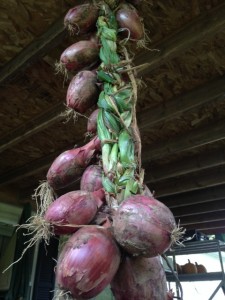
In seed catalogs, onions are classified as short, intermediate, or long day length onions. You must choose the right type for your spot on the earth. Farms in northerly latitudes in the Northern Hemisphere have long summer days so they should grow long day onions. Farms in southerly latitudes have shorter summer days, so short day onions are most appropriate there. Here in Northern Kentucky, I am almost at 39 degrees latitude, which is the southern edge of the long day onion zone. Most long day onions switch from growing green tops to making big bulbs once there is at least 14 hours of day length, and at my latitude that occurs after May 6 and lasts until August 5. That isn’t as large of a window for bulb formation as Maine or Washington, but it’s still three months, and my onions seem to be small to medium in size, accordingly. The problem with growing short day onions here is that they may bolt (i.e., go to seed) before forming a bulb. Overall, I am happy with the varieties I grew this year, and I will continue to try different long day onion varieties. I wish I had started my onions earlier, tended to them better when they were little baby onions in the greenhouse, and got them transplanted in the field earlier, but even so, I have a lot of onions to show for my efforts this year.
Curing, Storing
With only two days of August left, we have entered a new phase at the farm: bulk harvesting. To this point in the season, everything that we bring to the market has been picked fresh with the exception of potatoes, which we normally dig less than a week before the market, wash, dry, and let cure for 1-3 days. Today, things changed. We began harvesting our winter squash (pie pumpkins, butternut, delicata, and acorn squash), which we will now let cure before we begin bringing them to the market. Next up will be storage onions, which also need time to cure before they can come to the market. Before too long, we will have beans to pick, dry, shell, and store. Then come sweet potatoes and two varieties of potato that we still have left out in the field.
Storage vegetables all require different conditions for curing, which is the process of toughening up the skin so the vegetables aren’t susceptible to invasion by rotting organisms like mold, fungus, and bacteria. After the vegetables have cured, they want different conditions for storage so they remain in a stable condition until you’re ready to eat them. Curing and storing vegetables can be tricky, especially if you don’t have large, well-ventilated climate controlled areas, so a new farmer like me has to make the best use of the spaces that we’ve got. Winter squash, once they are picked ripe off of their vine, want to sit in a well-ventilated area that is warm (70-80 degrees F). This allows the stem of the squash to dry up and the skin to thicken, creating a nice sealed exterior impenetrable to rot organisms. If the squash isn’t nicked or bruised, it can survive a very long time, sometimes all through the winter and into the spring! I don’t have a space right now that can provide these conditions for hundreds of pounds of winter squash, so my best alternative is to put them in a greenhouse. While the greenhouse is currently hotter and not as well-ventilated as I’d like, the winter squash will at least be dry, warm, and elevated off the ground. Elevation is important for air circulation and for keeping the squash a little bit out of the way of bugs and rodents that would like to eat them.


I could have allowed my winter squash to continue sitting in the field on their vines and let them cure out in the open air. With lots of hot, wet days in the forecast, however, I didn’t want to run the risk of having my squash rot, especially because most of their vines have died back and therefore aren’t providing the life support the squash need to fight off the agents of rot. Also, as the squash sit in the field, their starches convert to sugars and they become more delectable to the palates of deer and other vermin. So, I decided that it was finally time to get the winter squash up and out of the field. Now we can cut down the forest of weeds that have grown up around the winter squash, and hopefully sow some quick growing cover crop to help return some fertility to the soil and create a dense stand of cover crop instead of a dense stand of weeds.

The squash will only need a couple of weeks to cure before I can put them in storage, which will likely be on a covered porch where they will be out of the sun and rain. There they will remain until the temperature drops below about 50 degrees. Once that happens, I will need to bring them indoors so they can remain cool, but not too cold. Ventilation is also important in the storage phase. Hopefully, I will have a lot of my winter squash sold by the time 50 degree weather comes around. Whatever is remaining will go on shelves in my house until I sell it or eat it all. And I plan on eating A LOT of squash this winter – aside from being delicious, winter squash are packed full of nutrients and may help fight seasonal affective disorder during cold and short winter days.

Once I have time and money to add more infrastructure to my farm, it would be fantastic to have dedicated curing and storage areas for my winter squash and other storage vegetables, especially because storage vegetables allow a farmer to continue to make sales well after the growing season has ended. Last year, when I worked at Local Roots Farm outside of Seattle, the farmers, Siri and Jason, purchased an insulated shipping container for storing winter squash. The container had vents on one end that could be opened or closed to help regulate the temperature and it had a dehumidifier and a fan to keep the air moving and at the right humidity. We still had some squash rot in storage, but for the most part, it allowed us to keep literally tons of squash safely stored through the fall and winter. You can read more about the shipping container here on the Local Roots Farm blog.
Picking, carrying, sorting, wiping, and moving winter squash can be a tedious task, but luckily Chris and I had many extra hands on deck today. Many thanks go to our parents, Jana, David, Sue, and Roger. With their help, we managed to not only pick the majority of the winter squash patch, but also pick all the tomatoes for market tomorrow, and we finished up before lunch and the onset of rain for the next couple of days. I’m quite glad the winter squash are spending the night dry and under cover instead of out in a warm, wet field.
After the Market
The past few weeks at the farmers market have been the busiest of the year. There are a few factors contributing to this, as far as I can tell. With cooler-than-normal temperatures this summer, folks have been out enjoying the weather and spending a little extra time at the market, especially now that it’s corn, tomato, and watermelon season. There are so many beloved summer vegetables ripe and ready right now that it is truly the best time of year to visit the market. Chris and I have spent some long days harvesting in preparation for the busy July and August markets, and every time we pack up the truck to head to the market, I am amazed that we are able to fit everything. We like to keep our booth stocked for the duration of the market, rather than run out of things early, which means we often come home with leftover vegetables. When I worked at Local Roots Farm in Seattle, leftover vegetables weren’t a problem. We had an honor system farm stand on the road where we could sell nice leftover vegetables, and anything that was wilted could go to our laying hens or pigs. Here at Dark Wood Farm, I don’t have a farm stand, and we don’t have any farm animals except for Smudge the cat, and she’s not too keen on leftover chard. So you might be wondering what we do with our leftover veggies, and the answer is – we do lots of things! Chris and I both love to cook, so in the days following a farmers market, we prioritize cooking with the items left over from market. For example, today I used up one bunch of sorrel, a bunch of chard, three onions, some leeks, a tomato, and several peppers, and that was only for one meal – lunch!

Whatever we don’t eat either gets stored, sold, donated, composted, or preserved. Here’s a little bit about each of these avenues:
Some leftover items, like potatoes, will store perfectly fine until our next market in a few days, so we hang on to those. The tricky part about holding vegetables until the next market is finding a good place to store them. Each vegetable has a preferred temperature and humidity, so you often can’t store everything in one place. Some veggies need to be refrigerated, some don’t. Most of them need to be kept out of the sun and out of the reaches of rodents or other animals looking for a feast.
Some of the higher demand items get sold to friends, family, and neighbors, especially the ones that live along the road between the market and the farm. From time to time, the Rabbit Hash General Store, just 3 miles down the road, will sell some of my nice leftover goods. We also donate lots of greens and other perishable items to a food pantry run by CAIN – Churches Active in Northside. They pick up the veggies right at the end of our Wednesday market in Northside, then stock their pantry for guests on Thursday morning.
Surprisingly, when all is said and done, we have very little vegetable matter leftover to compost. I started two compost bins when I moved onto the farm in January. They are simply cylinders of wire mesh with a few support poles. They are each three feet tall and a foot and a half wide. I dump vegetable scraps inside the cylinder and then top it with a handful or two of carbonaceous or “brown” material like dry leaves. Lately, I have been using some of the chaff I winnowed off of my mustard crop mixed with some cocoa bean husks that I picked up from the new chocolate shop at Findlay Market, Maverick Chocolate. These dry materials help balance out the wet, nitrogenous food and veggie scraps and keep the compost smelling pleasant. I’m 8 months in, and the first cylinder is only about 60% full! As all the microbes and insects quickly work their way through the compost during the heat of the summer, the volume compresses, even though Chris and I are adding a couple bowls of fresh material every day.

For me, the most exciting aspect of market leftovers at the moment is the opportunity it provides to squirrel food away for the winter. This past winter, when I first moved onto the farm, my pantry was bare except for a few winter squash, shallots, garlic, and root vegetables that I stowed away in little nooks and crannies of my car when I left Local Roots and moved home to Kentucky. Luckily, I quickly befriended some local farmers including Barry at Red Sunflower Farm, and he was kind enough to share some frozen beans, squash, and canned tomatoes to help me get through the winter until the first asparagus and rhubarb peeked through this spring. Now that my farm is in full abundance, I intend on stocking my pantry for the winter so that I can eat some healthy farm foods even when the ground is frozen. A couple weeks ago, I wrote about drying herbs and saving mustard seed, and I mentioned how I had been putting off canning because of how hot it makes the kitchen. Now that tomato season is here, I’ve had to suck it up and deal with the heat in the kitchen. At the end of each market, I normally have some dented and bruised tomatoes that didn’t survive the truck ride to the market, so they have been going into the canning pot then onto my shelf for making chili and tomato-y beans and greens this winter.



I am growing a small Italian heirloom tomato called Principe Borghese, which no one seems to want to buy. I decided to try growing it when I read in the seed catalog, “used for sun-dried tomatoes as it has few seeds and little juice.” Sun-dried tomatoes! YES! I love sun-dried tomatoes, so I was sure that several of my market customers would be excited about a tomato that is exceptional for drying. Well, my instincts perhaps were wrong, because I normally bring home 75% of the Principe Borghese tomatoes that I pick. I’m not worried about it, though, because it takes me about 10 minutes to cut up the leftover Principe tomatoes and put them in the dehydrator, then in 48 hours I have a jar full of aromatic sun-dried tomatoes.

My latest experiment in food preservation is homemade hot sauce. I am bringing two types of hot peppers to the market currently: green jalapenos and fish peppers. They have been selling so-so, and after Wednesday’s market, I had a pint of each that no one bought so I decided to try making green hot sauce. Following this recipe online, I chopped the peppers in my food processor with some salt, then transferred the hot pepper puree to a jar to ferment overnight. The next day, I added vinegar, and I am currently letting it sit for a week to develop flavors before I will sieve out the pepper chunks and put the liquid hot sauce into a bottle.

Jalapeno and fish hot peppers; hot sauce in the making!

Instead of looking at my leftover market vegetables as a burden, I choose to look at them as a challenge. How can I find more outlets for my vegetables, how can I improve my composting system, which new recipes can I explore, and how can I preserve these vegetables so I have food from my own farm when fresh vegetables are out of season? I am learning so much from these challenges, and setting myself up to have a winter with fewer trips to the grocery store, so I am thankful for the overabundance.
Tasty Tomatoes
My friend, Morgan, had Chris and me over for dinner last night, and she put in a special request that we bring over some heirloom tomatoes. I was happy to oblige; we have plenty of them at the moment, and we are excited to share them with our friends and family. I brought over several varieties and we taste tested at least three, all of which where juicy, dense, and sweet. Morg asked, “Why do heirlooms taste so much better?” and I thought y’all might have the same question, so here’s my answer in several parts:
Let’s start by discussing just what the heck makes a tomato (or any other vegetable, for that matter), an “heirloom.” Do any of you have an old piece of jewelry or antique passed down through your family? When I turned 15, my aunt, Jennifer, gave me a little gold ring that she had received on her 15th birthday from my great grandmother, Mutzi. In turn, Mutzi had received the ring on her 15th birthday from her father. That’s an heirloom. Something that has been passed down over the years through the generations of a family. Now, let’s shift the gears and talk about heirloom vegetables. In the days before seed catalogs, folks would save seeds from the myriad vegetables they were growing for fresh eating and preserving, and plant those saved seeds in subsequent year. In fact, a family could save the seed from their best, most flavorful, most vigorous and healthy plants, and by doing that every year, improve their vegetables’ taste, texture, and production at that specific location. Let’s fast forward to what agriculture looks like today. We now live in a world where vegetable production has converted from diverse backyard gardens to large-scale monocultures, meaning vast acreages of one crop, often picked by a machine instead of by a human hand. We also live in a world where we seldom walk out the back door, pick our vegetables, and eat them immediately. Instead, we go to the grocery store and buy vegetables that were picked at an unknown date, packed, and shipped some unknown number of miles away. For a vegetable to be “successful” in today’s agricultural world, it must maximize production per acre, be easy to pick by a machine, be easily washed and packed, resist bruising during shipping, sit stably on a shelf for an untold amount of time, be uniform in color, shape, and size so it displays nicely, and last for weeks in your refrigerator’s vegetable drawer. So, instead of seed that has been saved by families for flavor, ripeness, and vigor in a specific location, we now eat vegetables from seeds that were saved for uniformity, hardness (for shipping purposes), and shelf stability. Note that I did not include “flavor” in that list. To achieve these modern goals, people have done crazy things to seeds, including inserting genetic material from other life forms into the DNA of vegetables, making them genetically modified organisms, or GMOs.

Most vegetables develop flavor as they approach ripeness. This is especially the case with tomatoes. Ever eat one of those hard, white-in-the-center, tomatoes from the grocery store in January? They have absolutely no flavor because they were picked under-ripe to keep them hard for shipping. A tomato that is allowed to ripen on the vine has time to develop sugars, which cause the tomato to be soft to the touch, juicy when cut, fragrant, and sweet. The sugars also cause the tomato to rapidly decay and soften if you don’t eat them shortly after they are picked. A soft, sugary tomato does NOT travel well, and it certainly doesn’t travel well over thousands of miles. Really, the only way to get your hands on one of these babies is to grow them and pick them yourself or to buy them from someone growing them nearby. This is where your friendly, small-scale farmer comes into play. Small-scale farmers can pick tomatoes by hand, noting which are at their peak of ripeness, handle them gently, and deliver them to a market or to your doorstep in a short amount of time. Small-scale farmers can peddle even the ugliest of tomatoes, including cracked and crazy-looking tomatoes (as heirlooms often are), because they can talk with their customer one-on-one, describe the flavor, describe their growing practices, let you smell, touch, and even taste test the vegetables. Farmers that grow for wholesale simply can’t do this.

While I do have my great grandma’s heirloom ring, I don’t have any heirloom seeds that were passed down in my family. Luckily, there are a lot of small-scale growers out there, dutifully saving seeds from old heirloom varieties and sharing them with other farmers. This year, I ordered most of my seeds from Fedco, a seed co-op based in Maine, and Southern Exposure Seed Exchange, which is a network of growers that specialize in varieties that grow well in the Mid-Atlantic and Southeastern US. Through the hard work of these growers, many heirloom varieties live on and are available for growers like me – new farmers just getting started and in need of delicious locally-adapted varieties to grow for their friends, family, and neighbors.

Making Mustard
I spend a lot of time sharing news about the farm and the farming process, but I haven’t been too good about sharing homesteading stories. Part of the reason I decided to become a farmer and live on my farm is because I like growing and preserving my own food. Mainly because I love to eat and eat well. When I first moved onto the farm this winter, I decided to try tapping some of the maple trees on the property to make my own maple syrup. I ended up tapping three trees and got enough syrup to keep my pancakes topped throughout the year, with a few jars of syrup to spare to give as gifts to my family. Currently, the veggies and fruit are rolling in, and it seems like I can’t find enough spare time to do all the canning I’d like. Plus, my gas stove heats the kitchen up sooo much that I’ve convinced myself I’ll do all my pickling and canning when the fall comes and I can use the extra heat in the kitchen. For now, most of the food preservation I have been doing involves drying herbs. I can deal with the heat that the dehydrator puts off, plus I’ve been passively drying a bunch of herbs by hanging them upside down from a curtain rod in the kitchen. Any extra bunches of basil, tulsi, and coriander that I bring home from the market go right up on the “drying rod” until they are crispy dry, then I strip the leaves or seeds off the bunches and store them in a dry mason jar. It makes me excited for spices and tea this winter when my garden is under lots of snow.

Earlier this week, I harvested a crop of mustard seeds from the garden. In April, I planted white mustard, Sinapis alba, which is used to make the table mustard we’re all used to eating. Your basic mustard comes from grinding down the seeds of this plant, and adding it to water, vinegar, or other liquids and spices. For example, dijon mustard typically includes white wine as one of the liquids. Additionally, the super yellow color we normally associate with mustard comes from the addition of turmeric, although I’m sure a lot of cheap store-bought mustard just uses food dyes these days. You can also use seeds from other mustard plants to make different kinds of mustard. In the past, I have grown brown mustard, Brassica juncea, and used it to make spicy brown mustard.
After the initial April planting of white mustard, the plants grew quite quickly and were in full flower by the end of May. And, boy, did the bugs love those flowers. It was a veritable bug orgy down there in the mustard patch.

Slowly, the flowers turned into green seed pods that plumped up and filled with green seeds. Then, the seed pods began to dry up, turn brown, and the seeds inside turned from green to tan/yellow. A few days ago, while the weather was dry, I decided that the majority of the mustard plants were dry enough, and that I should harvest them before they shattered, which happens when the plant gets so dry that the pods burst open and spew their seeds all over the ground.

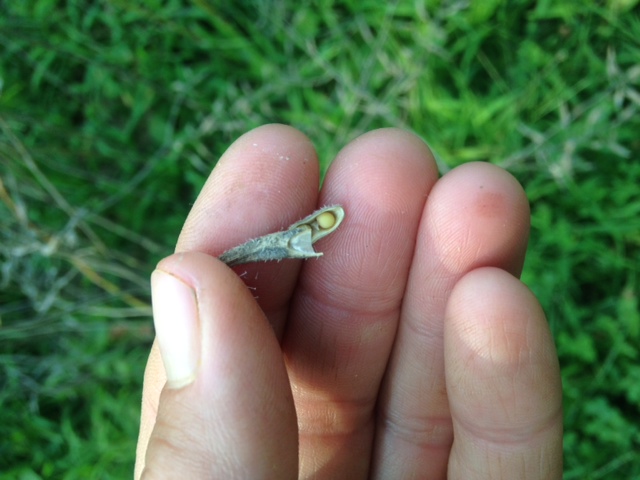
To harvest the seed, I cut down handfuls of the plants, and shook them into a large, clean garbage can, causing the seed pods to shatter and release their seeds. This process is called threshing. It took me 2 hours to thresh 250 square feet of densely growing mustard. A mechanical harvester would be a whole lot quicker, but I don’t have a mechanical harvester, and I enjoy spending time in the garden doing repetitive work. It lets me relax, listen to the birds, and let my thoughts wander. At the end of the two hours, I had a can of mustard seeds and shattered seed pods, and I left the remains of the mustard plants, or “straw”, behind to compost back into the soil.
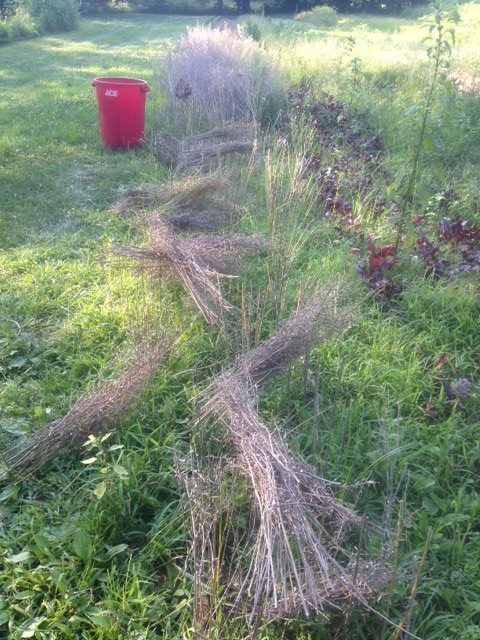

When I finished the threshing process, I brought my garbage can of seeds and pods to my kitchen and sifted it all through a strainer to separate out the seeds from the pods. There is still a little bit of chaff, or non-seed material, in with the seeds, so on the next low humidity day, I will take them outside with a fan and pour the seeds into a bucket in front of the fan to let the lightweight chaff blow off. All in all, I will have around 4 lbs of mustard seed, which I will use to make mustard, spice up dishes, and to make my new favorite condiment, pickled mustard seed, or “mustard caviar.” It’s a whole lot more work than buying mustard at the store, but at the end of the day, I love that my mustard will be homegrown, and the mustard patch was a huge benefit to the garden. It provided habitat for all kinds of beneficial insects during the flowering stage, its straw will help feed the soil, and because it was such a dense stand of tall plant material, it helped to keep weeds from sprouting underneath. Also, recent research has shown that growing mustard as a cover crop helps to fend off some of the pest insects and nematodes that live in the soil. All of that is wonderful, but honestly, I’m most excited about tasting my homemade mustard because, like I said, I love to eat.






